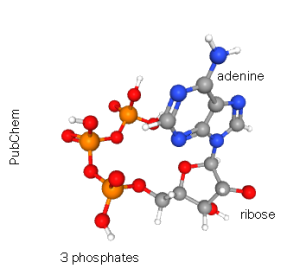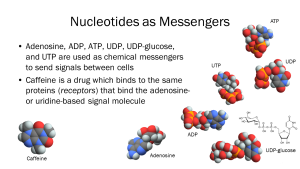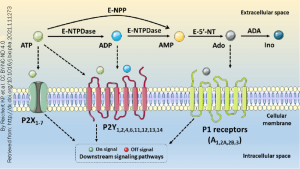Neurotransmitters: Purines
Lyndsay Woelfel and Jim Hutchins
Chapter under construction. This is the first draft. If you have questions, or want to help in the writing or editing process, please contact hutchins.jim@gmail.com.
What is a Purine?
A purine comes from purinergic neurotransmission, which is when ATP is released from nerves as either a transmitter or cotransmitter. This is so that it can act as an extracellular signaling molecule on pre-junctional and post-junctional membranes. These are found at neuroeffector junctions and synapses. They also act as a trophic factor in development as well as regeneration.
 A purine is a compound and is used to make up the building blocks of both DNA and RNA.
A purine is a compound and is used to make up the building blocks of both DNA and RNA.
Chemical Makeup
A purine is composed of carbon and nitrogen. It’s molecular formula is C5H4N4. They include adenine and guanine as well, which is how they are able to contribute to DNA and RNA formation. They also include a lot of other biomolecules. This includes ATP, cyclic AMP, NADH, GTP and coenzyme A. A basic model of purine includes nine atoms in its structure

Purine Function
The function of a purine is to provide energy, be a metabolic signal, control cell growth, and they also come together to become essential coenzymes.
 Purine Forms
Purine Forms
Purines include isoguanine, caffeine, uric acid, theobromine xanthine, and hypoxanthine.
Purine Receptors
The figure below represents purine release and metabolism. In this model, ATP is used as a signaling molecule as well as energy. Vesicular nucleotide transporters (VNUT) package ATP into vesicles. This provides their exocytotic release pathway. ATP is rapidly hydrolyzed into adenosine in the extracellular space by ectoenzymes. Purines act through P1, P2x and P2y receptors. Through either equilibrative or concentrative nucleoside transporters (ENT or CNT), adenosine is taken up into cells and metabolized into uric acid or ATP through adenosine kinase and AMP.

References
https://pubmed.ncbi.nlm.nih.gov/31646477/
https://www.britannica.com/science/purine
https://www.sciencedirect.com/science/article/pii/S0753332221000585
Media Attributions
- Ribonucleotide © Binhtruong is licensed under a CC BY-SA (Attribution ShareAlike) license
- Adenosine-5′-triphosphate Conformer © PubChem adapted by Jim Hutchins is licensed under a Public Domain license
- Purines as extracellular signals © PubChem adapted by Jim Hutchins is licensed under a Public Domain license
- Overview of the purinergic signaling cascade © Karine Paula Reichert, Milagros Fanny Vera Castro, Charles Elias Assmann, Nathieli Bianchin Bottari, Vanessa Valéria Miron, Andréia Cardoso, Naiara Stefanello, Vera Maria Melchiors Morsch, Maria Rosa Chitolina Schetinger is licensed under a CC BY-NC-ND (Attribution NonCommercial NoDerivatives) license

